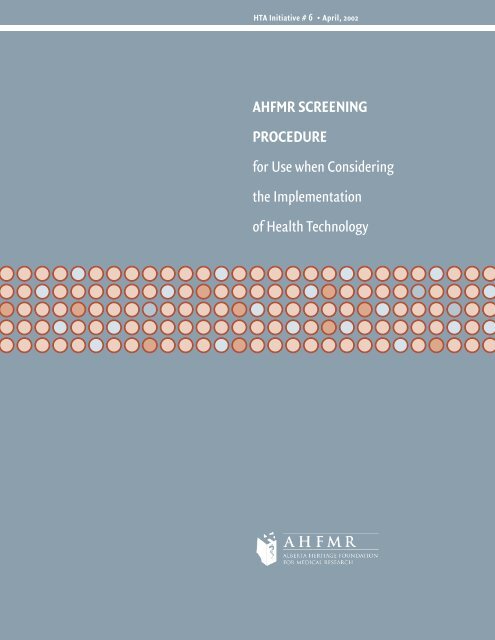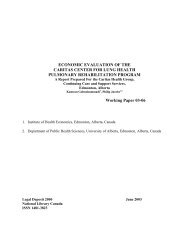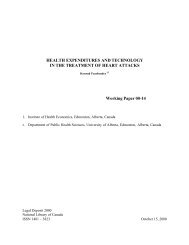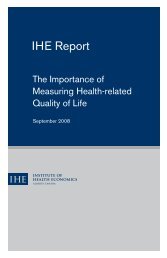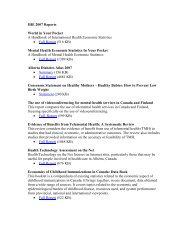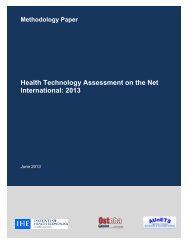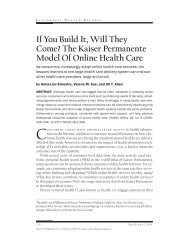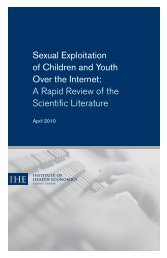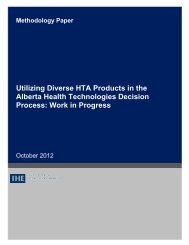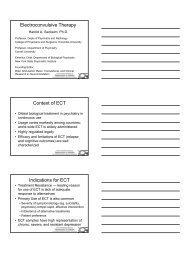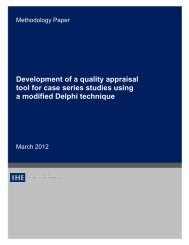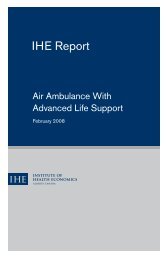AHFMR SCREENING PROCEDURE for Use when Considering the ...
AHFMR SCREENING PROCEDURE for Use when Considering the ...
AHFMR SCREENING PROCEDURE for Use when Considering the ...
- No tags were found...
Create successful ePaper yourself
Turn your PDF publications into a flip-book with our unique Google optimized e-Paper software.
HTA Initiative # 6 • April, 2002<strong>AHFMR</strong> <strong>SCREENING</strong><strong>PROCEDURE</strong><strong>for</strong> <strong>Use</strong> <strong>when</strong> <strong>Considering</strong><strong>the</strong> Implementationof Health Technology
Copies of this andour o<strong>the</strong>r publicationsare availableelectronically atwww.ahfmr.ab.caThis screeningprocedure is alsoavailable on <strong>the</strong> web inWord <strong>for</strong>mat and canbe customized to <strong>the</strong>user’s needs.Health Technology Assessment UnitAlberta Heritage Foundation<strong>for</strong> Medical ResearchSuite 150010104 – 103 Avenue nwEdmonton, AlbertaCanada t5j 4a7Tel: 780 423 5727Fax: 780 429 3509
HTA Initiative # 6 • April 2002<strong>AHFMR</strong> <strong>SCREENING</strong><strong>PROCEDURE</strong><strong>for</strong> <strong>Use</strong> <strong>when</strong> <strong>Considering</strong><strong>the</strong> Implementationof Health TechnologyPrepared by:Don JuzwishinDirector, Health Technology AssessmentAlberta Heritage Foundation <strong>for</strong> Medical ResearchWendy L. SchneiderConsultant, Health Services Research Associates
HTA Initiative #6<strong>AHFMR</strong> Screening Procedure<strong>for</strong> use <strong>when</strong> <strong>Considering</strong><strong>the</strong> Implementation of Health TechnologyCopyright © Alberta Heritage Foundation<strong>for</strong> Medical Research, 2002isbn 1–896956–52–1All rights reserved.Design: Interpret Design Inc.Alberta Heritage Foundation<strong>for</strong> Medical ResearchSuite 1500, 10104 – 103 Avenue nwEdmonton, AlbertaCanada t5j 4a7Tel: 780 423 5727Fax: 780 429 3509www.ahfmr.ab.ca
Table of ContentsIntroduction 1BackgroundPersonnel involved 2Diagram showing screening processOverview of <strong>the</strong> procedure 3DefinitionsChecklists and Reporting Sheets <strong>for</strong> <strong>the</strong><strong>AHFMR</strong> Health Technology Screening Procedure 5Record of Progress 6Checklist I: Prescreening Needs Assessment 8Checklist II: Evidence of Effectiveness 9Checklist III: Impact on Operations 10Checklist IV: Financial Assessment 11Executive Summary 12Vendor and Equipment Checklist I: Overview of Cost Estimates 13Vendor and Equipment Checklist II: Vendor Comparison 14Vendor and Equipment Checklist III: Cost Comparison 15Vendor and Equipment Checklist IV: Overview of Cost Estimates 16
<strong>AHFMR</strong> <strong>SCREENING</strong> <strong>PROCEDURE</strong> 1Introduction“This screening process shouldbe applied in <strong>the</strong> regional contextaccording to <strong>the</strong> criteria ofvolume, risk, cost, quality, andaccessibility to healthcare.”Note: This Health Technology ScreeningProcedure is not intended to be used<strong>for</strong> evaluating Programs.An additional document is being developedthat will be specific to screening <strong>for</strong>Program addition, deletion and/orexpansion.As part of its strategic plan <strong>the</strong> Health Technology Assessment Unit(HTA) of <strong>the</strong> Alberta Heritage Foundation <strong>for</strong> Medical Research (<strong>AHFMR</strong>)is committed to assisting Regional Health Authorities (RHAs) developand maintain a capacity <strong>for</strong> using evidence in <strong>the</strong>ir policy and decisionmaking.The Framework <strong>for</strong> Regional Health Authorities 1 describes how RHAs canimplement an applied HTA process.This report presents <strong>the</strong> <strong>AHFMR</strong> Screening Procedure which is made upof a series of checklists designed to guide RHAs through an applied HTAprocess and help <strong>the</strong>m decide on suitable health technologies <strong>for</strong> <strong>the</strong>irregion. The process serves to structure <strong>the</strong> manner by which proposalsfrom physicians and staff advance <strong>the</strong> introduction of new technology,procedures, or standards of care.The purpose of <strong>the</strong>se checklists is to identify <strong>the</strong> evidence necessary <strong>for</strong>decision-making and to assist RHAs with <strong>the</strong>ir annual business planningcycle. This ef<strong>for</strong>t will in turn provide health regions with a structuredframework <strong>for</strong> determining whe<strong>the</strong>r to introduce an emerging health caretechnology or if <strong>the</strong>y should reassess a technology currently in use. Thisscreening process should be applied in <strong>the</strong> regional context according to <strong>the</strong>criteria of volume, risk, cost, quality, and accessibility to healthcare.BACKGROUNDFour sources have been referred to in <strong>the</strong> development of <strong>the</strong>se checklists:<strong>the</strong> New York Hospital Association, <strong>the</strong> Capital Health Region in BritishColumbia, <strong>the</strong> Surgical Suites of <strong>the</strong> Calgary Regional Health Authority and<strong>the</strong> University HealthSystem Consortium in Illinois. In addition, workshopparticipants from various Alberta Regional Health Authorities are gratefullyacknowledged <strong>for</strong> providing valuable feedback during three workshops heldin Red Deer, Grande Prairie and Lethbridge. It was this contribution tha<strong>the</strong>lped develop and customize <strong>the</strong> screening procedure <strong>for</strong> use in Alberta.A final workshop was held in March 2002 to validate <strong>the</strong> contents of <strong>the</strong>checklist and make improvements.The checklist was developed in a generic sense, leaving ample room <strong>for</strong>health regions to customize it to <strong>the</strong>ir own needs and requirements.1. Juzwishin, D. Framework <strong>for</strong> Regional Health Authorities to Make Optimal <strong>Use</strong> of Health Technology Assessment(HTA Initiative #1). Alberta Heritage Foundation <strong>for</strong> Medical Research, March 2000.
2 <strong>AHFMR</strong> <strong>SCREENING</strong> <strong>PROCEDURE</strong>Personnel involvedPrescreening.....of technology...indicates..fur<strong>the</strong>r research.....should not be.......undertaken.........New technologyis notapprovedNOSponsor of technologyinitiates processPrescreeningchecklistis completedCompleteresearch andcompile in<strong>for</strong>mationrequired onchecklists I–IVWriteExecutive Summaryand presentto RHA ExecutiveFollow-upevaluation oftechnologyYESFur<strong>the</strong>r researchis approvedand a projectteam is selectedNew technologyis approved andimplementedIf <strong>the</strong> complexity of <strong>the</strong> technology involves o<strong>the</strong>r health care providers,has requirements beyond existing resources, and/or has special spacerequirements, <strong>the</strong>n a project team should be <strong>for</strong>med to help review <strong>the</strong>appropriateness of <strong>the</strong> health care technology. Roles of <strong>the</strong> individualsinvolved are described here:Sponsor The person requesting <strong>the</strong> acquisition of a new technology, or<strong>the</strong> assessment or re-application of an existing technology. Typically <strong>the</strong>sponsor would have clinical involvement with <strong>the</strong> particular technology. Thisperson is responsible <strong>for</strong> completing <strong>the</strong> Prescreen and, toge<strong>the</strong>r with teammembers, <strong>the</strong> rest of <strong>the</strong> checklists.Project Leader The project leader will most often be <strong>the</strong> clinical sponsorof <strong>the</strong> technology. However, it could also be a program head or a seniormanager. Whoever it is, he/she should have <strong>the</strong> support of someoneknowledgeable in accessing, appraising and applying health servicesresearch to policy or decisions (e.g. SEARCH participant or knowledgebroker).Project Team Members The project leader can <strong>the</strong>n select team membersto join <strong>the</strong> team who will represent <strong>the</strong> different disciplines or relevantparts of <strong>the</strong> organization that will be impacted by <strong>the</strong> introduction of<strong>the</strong> technology. It is appropriate to involve as many significant players aspossible on <strong>the</strong> team to fully appreciate <strong>the</strong> implications of introducing a newtechnology.Knowledge Broker The team will require <strong>the</strong> expertise of an individualwho is knowledgeable about where to find <strong>the</strong> relevant evidence, assessits usefulness to <strong>the</strong> questions being asked, and to apply it to <strong>the</strong> localcircumstances.DIAGRAM SHOWING <strong>SCREENING</strong> PROCESS.
<strong>AHFMR</strong> <strong>SCREENING</strong> <strong>PROCEDURE</strong> 3Overview of <strong>the</strong> procedureDEFINITIONSFollowing are several terms that shouldbe clarified.Accessibility Ability of client to reachor use services; <strong>the</strong> services are ei<strong>the</strong>rrequired or available, provided in <strong>the</strong>most appropriate setting and at <strong>the</strong>right time, and based on clientsrespective needs.Cost Anticipated expenditure on a unitand also cumulative basis.Materiality The monetary value ofsupplies, equipment and/or servicesthat is significant to <strong>the</strong> RHA thattriggers <strong>the</strong> use of <strong>the</strong> checklist.Risk Chance or possibility of danger,loss or injury.Technology This includes medicaldevices, drugs, procedures, equipment,as well as <strong>the</strong> organization of services.Volume Number of cases projectedover a period of time (caseload).Step 1: Prescreen <strong>the</strong> particular health technology by completingChecklist I – Prescreening Needs AssessmentIf no need is established <strong>for</strong> <strong>the</strong> technology <strong>the</strong>n do not proceed.Step 2: Form <strong>the</strong> project teamIf <strong>the</strong> technology is complex and has significant implications <strong>for</strong> potentialintroduction or reapplication in <strong>the</strong> organization it is recommended that aproject team of impacted individuals be <strong>for</strong>med to study and in<strong>for</strong>m <strong>the</strong>matter.The sponsor acts as project leader or delegates this role to a team member.Step 3: Complete Checklist II – Evidence of EffectivenessDetermine if <strong>the</strong>re is peer reviewed scientific evidence to support <strong>the</strong>introduction of <strong>the</strong> new technology, or <strong>the</strong> continuing reapplication of anexisting technology. Include <strong>the</strong> ‘level of evidence.’ The HTA Unit of <strong>the</strong><strong>AHFMR</strong> may be approached to assist with access to evidence.If <strong>the</strong>re is a lack of published evidence and <strong>the</strong>re<strong>for</strong>e uncertainty to support<strong>the</strong> introduction of <strong>the</strong> technology <strong>the</strong>n a decision will have to be made within<strong>the</strong> local context as to whe<strong>the</strong>r <strong>the</strong> sponsor should proceed with <strong>the</strong> screeningprocedure.The sponsor or project team must complete <strong>the</strong> checklist to <strong>the</strong> extent thata decision-maker can clearly determine if <strong>the</strong> technology being sponsored isappropriate <strong>for</strong> introduction in <strong>the</strong> setting being proposed.Step 4: Complete Checklist III – Impact on OperationsDetermine <strong>the</strong> potential impact of <strong>the</strong> technology on internal operations and<strong>the</strong> quality of care.This checklist may involve all members of <strong>the</strong> project team – each examining<strong>the</strong> impact of <strong>the</strong> technology on <strong>the</strong>ir areas.Step 5: Complete Checklist IV – Financial AssessmentDetermine <strong>the</strong> financial impact of <strong>the</strong> new technology by comparing <strong>the</strong> newtechnology with current systems. This includes capital costs, staffing costs,operating costs as well as offsetting revenue, cost avoidance, and cost savingvis a vis existing technology. These financial implications are considered both<strong>for</strong> startup and continuing costs.
4 <strong>AHFMR</strong> <strong>SCREENING</strong> <strong>PROCEDURE</strong>Step 6: Prepare Executive SummarySyn<strong>the</strong>size <strong>the</strong> in<strong>for</strong>mation from <strong>the</strong> completed checklists, ensure fulldisclosure of <strong>the</strong> implications of <strong>the</strong> technology’s introduction. Include <strong>the</strong>names, departments, and signatures of <strong>the</strong> sponsor, team leader and teammembers. Potential conflicts of interest should also be disclosed.Step 7: Present findings to <strong>the</strong> RHA ExecutiveAfter <strong>the</strong> sponsor and team members have signed off <strong>the</strong> completedchecklists, and composed <strong>the</strong> Executive Summary, <strong>the</strong> package is <strong>for</strong>wardedto <strong>the</strong> appropriate decision-making body within <strong>the</strong> RHA.Step 8: Approval or disapproval by <strong>the</strong> RHA ExecutiveThe executive of <strong>the</strong> health authority will approve, disapprove or request moredetails in respect to <strong>the</strong> proposal.• If <strong>the</strong> proposal is approved it will require that an implementation strategy<strong>for</strong> <strong>the</strong> introduction of <strong>the</strong> technology is developed.• If it is disapproved <strong>the</strong> rationale will be provided to <strong>the</strong> sponsor.• If more in<strong>for</strong>mation is required be<strong>for</strong>e a decision can be made, this will bedirected to <strong>the</strong> sponsor or project leader.Step 9: Implementation of technologyOnce <strong>the</strong> technology is approved, <strong>the</strong>n <strong>the</strong> process of acquiring, installing,training begins.Step 10: Follow-up evaluation of technologyOnce technology is operational it should be evaluated according to originalparameters after a given period of time.Step 11: Prepare Post-Implementation Evaluation ReportDescribe <strong>the</strong> outcome measures, timelines, and processes that will be usedto evaluate <strong>the</strong> initiative if approved <strong>for</strong> implementation. Accountability <strong>for</strong>completing <strong>the</strong> evaluation must be indicated and acknowledged within <strong>the</strong>plan.
<strong>AHFMR</strong> <strong>SCREENING</strong> <strong>PROCEDURE</strong> 5Checklists andReporting Sheets<strong>for</strong> <strong>the</strong><strong>AHFMR</strong>Health TechnologyScreening ProcedureThese checklists and reporting sheets are alsoavailable on <strong>the</strong> web in Word <strong>for</strong>mat,and can be customized to <strong>the</strong> user’s needs.
6 <strong>AHFMR</strong> <strong>SCREENING</strong> <strong>PROCEDURE</strong>Record of ProgressThis reporting sheet is used to record milestones in <strong>the</strong> screening procedure in order to ensure <strong>the</strong> correct sequenceis followed.Health technology being considered1. Initial Presentation to RHA ExecutiveA) Sponsor completes Prescreen <strong>the</strong>n requests approval to move <strong>for</strong>ward:Sponsor signatureDateB) Health authority executive approves prescreen, Sponsor moves <strong>for</strong>ward with Screening Exercise:Senior Executive signatureDateC) Executive does not approve proposal <strong>for</strong> fur<strong>the</strong>r development:Returned to sponsor Yes Date returnedwith reasonsNoSenior Executive signatureDate2. Proposal Development by Project TeamA) Project Leader selected DateB) Project Team Members selected Date(select members from affected/related areas)Team MembersDepartment
<strong>AHFMR</strong> <strong>SCREENING</strong> <strong>PROCEDURE</strong> 7C) Screening Exercise Tracking: completion of checklistsI Prescreening Needs AssessmentSignatureII Evidence of EffectivenessSignatureIII Impact on OperationsSignatureIV Financial AssessmentSignatureDateDateDateDateD) Project Leader presents completed proposal to executive <strong>for</strong> final review.Senior Executive Signature* If approved, <strong>the</strong> proposal is integrated into <strong>the</strong> RHA business plan.Date4. Presentation to Board of Trustees(if required)Approved by Board Yes DateNo5. Implementation of TechnologyStart up date6. Technology Evaluation ReportSix months after introduction of <strong>the</strong> technology <strong>the</strong> Sponsor is responsible <strong>for</strong> evaluating itand providing <strong>the</strong> RHA senior executive with an evaluation report.Presentation to Senior ExecutiveDate
8 <strong>AHFMR</strong> <strong>SCREENING</strong> <strong>PROCEDURE</strong>CHECKLIST IPrescreening Needs Assessment(to be completed by sponsor)This checklist relates <strong>the</strong> technology under review to <strong>the</strong> characteristics of <strong>the</strong> health region communitythat affect <strong>the</strong> provision of quality health care. The community is surveyed to identify health care needs,resources, opportunities <strong>for</strong> <strong>the</strong> organization and possible barriers to <strong>the</strong> implementation andoperation of <strong>the</strong> technology.Health technology being considered—describe <strong>the</strong> proposed initiative or change in practice in relation to <strong>the</strong> currentstandard of care in <strong>the</strong> region.Materiality threshold <strong>for</strong> this Health Technology Screening Procedure $(to be determined by RHA Executive)Identifying a threshold avoids unnecessary work on something that is obvious – or stops work on something thatis unrealistic.Sponsor name(attach findings to this cover page)Title1) Describe <strong>the</strong> criteria or clinical indications <strong>for</strong> <strong>the</strong> use of thistechnology in <strong>the</strong> proposed population.2) Is <strong>the</strong>re a caseload volume necessary <strong>for</strong> clinician maintenance of skills?3) Identify <strong>the</strong> potential patient caseload (project 3–5 years).4) Describe <strong>the</strong> profile of <strong>the</strong> population that willbenefit by <strong>the</strong> technology.5) Identify major governmental, credentialing, and regulatory issues(e.g. Health Canada, U.S. FDA approvals, etc).6) Identify issues of duplication of services. Are substitutions possible?7) Identify opportunities <strong>for</strong> partnerships with o<strong>the</strong>r RHAs.8) Are <strong>the</strong>re resource issues that arise in your community asa result of introducing this technology? (brief explanation).9) Are those that will be affected aware of <strong>the</strong> potential impact?Date completedSponsor signatureDate of completion
CHECKLIST IIEvidence of Effectiveness(to be completed by sponsor and project team)<strong>AHFMR</strong> <strong>SCREENING</strong> <strong>PROCEDURE</strong> 9This checklist involves searching <strong>the</strong> scientific literature <strong>for</strong> good quality studies that examine recent experience with<strong>the</strong> efficacy and effectiveness of <strong>the</strong> proposed technology. Be aware of <strong>the</strong> distinction between clinical effectiveness and costeffectiveness. It is important to broadly survey <strong>the</strong> evidence, as emerging developments may render <strong>the</strong> technology obsolete.In addition to appraising <strong>the</strong> scientific literature, in<strong>for</strong>mation may be obtained from regulatory bodies, o<strong>the</strong>r users, andfacilities that have experience with <strong>the</strong> technology. It is not prudent to rely solely on in<strong>for</strong>mation from vendors, or technologymanufacturers(attach findings to this cover page)Health technology being considered1) Have you obtained approval to proceed from your Program Director/Department Head?2) a) Describe <strong>the</strong> Technology – in relation to <strong>the</strong> current standard of care in <strong>the</strong> region.Describe anticipated outcomes.b) Identify what <strong>the</strong> new technology is replacing, OR what indication is <strong>the</strong> entirely newtechnology treating/diagnosing, OR describe <strong>the</strong> reapplication of an existing technology.3) Is this technology being requested or changed as a result of an audit by <strong>the</strong> CSA, WCB,or o<strong>the</strong>r regulatory body?4) Are <strong>the</strong>re o<strong>the</strong>r alternatives to this technology? What are <strong>the</strong>y?5) a) Can this technology be accommodated in an alternative setting?(i.e. common location, shared services)b) Is this technology currently available elsewhere?c) Are <strong>the</strong>re opportunities <strong>for</strong> partnering with neighbouring RHA’s?d) Why would <strong>the</strong> health authority want to introduce this technology?e) Describe and assess <strong>the</strong> appropriateness of this technology to <strong>the</strong> health authority.6) Complete an appropriate literature search* and critical appraisal of <strong>the</strong> literature.• Clearly state <strong>the</strong> objectives <strong>for</strong> introduction of a technology or reapplication of an existing technology.• Identify <strong>the</strong> supporting evidence (level of evidence) related to <strong>the</strong> proposed technology.• Include a brief history of <strong>the</strong> technology.• If applicable, describe current standard of care <strong>for</strong> which <strong>the</strong> technology is being requested.• Summarize <strong>the</strong> findings from critically reviewed published evidence that shows <strong>the</strong> newtechnology/application is more effective/efficacious than standard of care.7) Where within <strong>the</strong> region will this technology be ideally located?8) Does this technology require specialized training or credentialing?9) Is <strong>the</strong>re potential to use this technology in o<strong>the</strong>r settings in <strong>the</strong> health authority?10) What is <strong>the</strong> potential impact of implementation of this technology on o<strong>the</strong>rprograms/departments/services?Date completed* If you require assistance in per<strong>for</strong>ming a thorough literature search or review contact a SEARCH participant in your health authority or <strong>the</strong> HTA Unit of <strong>the</strong> <strong>AHFMR</strong>.Sponsor name Sponsor signature Date of completion
10 <strong>AHFMR</strong> <strong>SCREENING</strong> <strong>PROCEDURE</strong>CHECKLIST IIIImpact on Operations(to be completed by sponsor and project team)The purpose of this checklist is to examine internal operational factors related to <strong>the</strong> introduction of <strong>the</strong> new technology.This helps to determine <strong>the</strong> organization’s requirements related to <strong>the</strong> new technology and identify any barriers or limitations.This checklist is also designed to determine <strong>the</strong> potential impact of <strong>the</strong> technology on quality of care.The initial screening <strong>for</strong> a new technology must include <strong>the</strong> following in<strong>for</strong>mation. Subsequent screenings need only be updated.(attach findings to this cover page)Health technology being considered1) Explain how <strong>the</strong> technology is consistent with <strong>the</strong> health regions business plan(Mission, Philosophy, Role Statement, Goals & Objectives)?2) Explain how <strong>the</strong> technology is consistent with <strong>the</strong> business plans of <strong>the</strong>Programs/Departments directly involved in implementing <strong>the</strong> technology?3) Is <strong>the</strong> technology complementary to o<strong>the</strong>r programs and services in <strong>the</strong> health region?Please describe.4) How does <strong>the</strong> technology impact access to care?5) How does <strong>the</strong> technology enhance <strong>the</strong> quality of care in <strong>the</strong> health region andhow does it tie in with <strong>the</strong> Total Quality Management of <strong>the</strong> RHA?6) Do we have <strong>the</strong> resources to properly identify <strong>the</strong> patients that will benefitfrom <strong>the</strong> technology?7) Is health region staff currently trained/certified to operate this technology?If not, what education/training is required?8) Describe <strong>the</strong> impact this technology will have on o<strong>the</strong>r programs, departments and/or services(eg. laboratory, OR, booking, etc.). Obtain signatures of all program leaders ofaffected departments.9) Will <strong>the</strong> provision of this technology generate additional demands on existing technologies?Specify <strong>the</strong> technologies affected and what <strong>the</strong> impact will be.10) Does implementation of this technology require additional space and/orrenovation work? Please provide provisional plans/estimates, as required.11) If possible, identify <strong>the</strong> lifespan of <strong>the</strong> technology.Date completedSponsor / Team Leader name Sponsor / Team Leader signature Date of completion
CHECKLIST IVFinancial Assessment(to be completed by sponsor and project team)The initial acquisition cost of a new technology – i.e. whe<strong>the</strong>r it is expensive or inexpensive - may not be indicative of <strong>the</strong>potential ongoing operating costs. A technology may have a low initial acquisition cost, but its frequency of use could resultin considerable operating costs. In order to assess <strong>the</strong> financial impact of <strong>the</strong> new or newly applied technology, a comparisonof <strong>the</strong> operating costs of <strong>the</strong> new versus <strong>the</strong> current technology is required. It is important that this analysis reflects <strong>the</strong>cost <strong>for</strong> all departments impacted by <strong>the</strong> implementation of <strong>the</strong> new technology.(attach findings to this cover page)<strong>AHFMR</strong> <strong>SCREENING</strong> <strong>PROCEDURE</strong> 11Health technology being consideredSignature1) Compare <strong>the</strong> current standard of care and new technology:a) Identify workload volumes – and assumptions supporting <strong>the</strong>mb) Determine staffing levels (Regular + Relief )– and implications <strong>for</strong> support areasc) Calculate:• Staffing costs• Supply costs• Offsetting revenue• Building systems• O<strong>the</strong>rDate completed2) Identify <strong>the</strong> technology that will be removedfrom service and replaced with new technology.(schedule of substitution must be included)3) Summarize <strong>the</strong> incidental “costs/savings,” andhow <strong>the</strong>se can be captured.4) Identify Capital Costs(equipment and construction/renovation)5) Identify operating costs (at different volumes of service)• Startup-operating costs (staffing and supplies,training)• Year 2/Year 3 operating costs (step-wise costs – variable + fixed)• Life of <strong>the</strong> technologySponsor / Team Leader name Sponsor / Team Leader signature Date of completion
12 <strong>AHFMR</strong> <strong>SCREENING</strong> <strong>PROCEDURE</strong>Executive SummaryHealth technology being consideredProvide a high level summary of <strong>the</strong> proposed technology, <strong>the</strong> proposed benefit to <strong>the</strong> region and <strong>the</strong> primaryrecommendations. (Attempt to place values on <strong>the</strong> benefits if possible.)Disclosure of potential conflict of interest: Provide specifics of any funding that you as sponsor or to your knowledge yourcolleagues and <strong>the</strong> program have received in <strong>the</strong> last five years from <strong>the</strong> company that manufactures and/or marketsany product associated with <strong>the</strong> initiative described above. This includes research (funding, grants, professional retainers,product evaluation initiatives, and /or educational support.Sponsor(s) Department Sponsor signatureTeam Leader Department Team Leader signatureTeam Members Department Members’ signatures
<strong>AHFMR</strong> <strong>SCREENING</strong> <strong>PROCEDURE</strong> 13VENDOR AND EQUIPMENT CHECKLIST IOverview of Cost Estimates(to be completed by purchasing department and customized accordingly)The purpose of this checklist is to examine <strong>the</strong> advantages and benefits of each vendor and/or item under consideration. Thecompletion of this checklist should determine <strong>the</strong> full operating requirements of <strong>the</strong> technology, <strong>the</strong> reliability and businessstrength of <strong>the</strong> vendor, and <strong>the</strong> scope of possible contractual agreements with <strong>the</strong> vendor. The unit under consideration shouldbe evaluated against comparable models available from o<strong>the</strong>r vendors, including <strong>the</strong> available options.A special warning is in order <strong>for</strong> technology that has recently been introduced. In many cases, no reliable in<strong>for</strong>mation willbe available, <strong>the</strong> price is likely to drop considerably <strong>the</strong> year following its introduction, and it may be rendered obsolete bya more refined version.Health technology being considered(attach findings to this cover page) Quote all prices in Canadian dollars.SignatureDate completed1) Proposed Equipment:<strong>Use</strong>r Department: Will this equipment/instrumentationreplace existing equipment/technology?2) Equipment Description:3) Approximate Price*: $4) Options/Accessories*: $5) Consumables:(Estimated annual cost) $6) Manufacturer/Distributor:7) Additional In<strong>for</strong>mation:8) Approximate Installation Price: $9) Estimated Construction/Renovation Costs: $(including drawing, if appropriate)*If at all possible obtain a written quotation from <strong>the</strong> vendor; avoid estimates.
14 <strong>AHFMR</strong> <strong>SCREENING</strong> <strong>PROCEDURE</strong>VENDOR AND EQUIPMENT CHECKLIST IIVendor Comparison(to be completed by purchasing department and customized accordingly)Health technology being considered(attach findings to this cover page)1) Manufacturer:Vendor #1 Vendor #2 Vendor #32) Distributor:3) Brand/Model :4) Market Release Date*:5) Head Office:6) Service Department:7) Delivery:8) Current <strong>Use</strong>rsComparison Info:* (Health Canada/U.S.FDA/CSA/UL Approval) For completion after approval of technology in some cases.
VENDOR AND EQUIPMENT CHECKLIST IIICost Comparison(to be completed by purchasing department and customized accordingly)<strong>AHFMR</strong> <strong>SCREENING</strong> <strong>PROCEDURE</strong> 15Health technology equipment being considered(attach findings to this cover page) Quote all prices in Canadian dollars.1) Base Price :Vendor #1 Vendor #2 Vendor #32) GST :3) O<strong>the</strong>r Expenses:4) Freight:5) Customs/Brokerage6) Installation:(By vendor)7) Installation:(by Health Region) *a) Utilities- Air- Plumbing- Electricalb) Construction- Weight/ Dimensions8) Consumables:(Estimated annual cost)* to be completed by Plant Services
16 <strong>AHFMR</strong> <strong>SCREENING</strong> <strong>PROCEDURE</strong>VENDOR AND EQUIPMENT CHECKLIST IVService and Warranty Comparison(to be completed by purchasing department and customized accordingly)Health technology being considered(attach findings to this cover page) Quote all prices in Canadian dollars.1) Warranty Period:Warranty Cost:Vendor #1 Vendor #2 Vendor #32) Service Contract:Term:Type:Price:3) Inservice Education:On site/Off site:Duration:4) Service Training:Level:Price:On site/Off site:5) Manuals:Operation:Service:Schematics:Troubleshooting:O<strong>the</strong>r:
www.ahfmr.ab.ca


